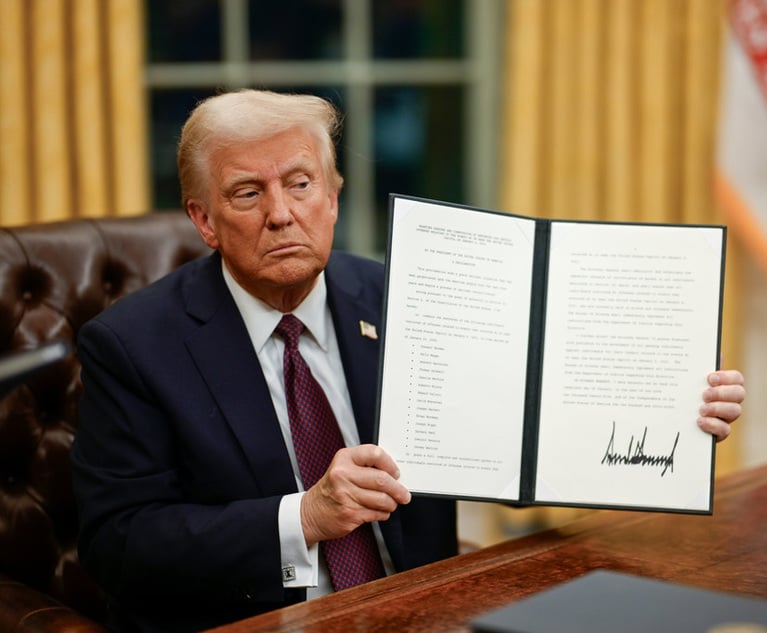Governor Cuomo Proposes $3 Billion 'Restore Mother Nature' Bond Act
Gov. Andrew Cuomo has started a campaign to pass legislation that would give voters the chance to approve a $3 billion environmental bond act titled the "Restore Mother Nature Bond Act." In their Environmental Law Column, Michael Gerrard and Edward McTiernan examine the background to, and purposes of this Act.
March 11, 2020 at 12:00 PM
7 minute read
 Michael B. Gerrard and Edward McTiernan
Michael B. Gerrard and Edward McTiernan
In each decade between 1960 and 1990, New Yorkers approved bond acts to support environmental programs ranging from land preservation to clean air and water to restoration of municipal landfills. However, no new environmental bonds have been approved since the Clean Water/Clean Air Bond Act of 1996, which is codified at N.Y. Envtl. Conserv. Law §§56-0101 to 56-0611. That could soon change. Gov. Andrew Cuomo has started a campaign to pass legislation that would give voters the chance to approve a $3 billion environmental bond act.
The "Restore Mother Nature Bond Act" is designed to complement New York's ambitious Climate Leadership and Community Protection Act, which was discussed in our column of July 11, 2019, by providing funds for the Department of Environmental Conservation (DEC) and others, to support nature-based projects that mitigate flood risks, restore natural habitats and improve storm resiliency. In this column we examine the background to, and purposes of, the nascent Restore Mother Nature Bond Act.
Under Article VII, §11 of the New York Constitution, the state can only undertake public borrowing when the debt is authorized by law and approved by the voters at a general election, and only one bond question may appear on the ballot per election. The present goal is for the Restore Mother Nature Bond Act to be approved by the Legislature and signed by the governor in time to be presented to the public at next November's election, when races for the White House, the entire New York Legislature and all of the state's 27 Members of the House of Representatives will also be on the ballot.
Many details of the Restore Mother Nature Bond Act remain to be developed. This is hardly unusual. In New York, bond proposals usually present general guidelines for how the money will be spent. Details about the spending priorities are found in companion legislation or formal or informal understandings between the Legislature and the governor. These can range from detailed funding criteria to a simple list of programs that qualify for bond act funds. However, Article VII, §11 of the Constitution, which requires a public referendum for most proposed public debt, also requires that bond funds be used "for some single work or purpose, to be distinctly specified therein."
The Court of Appeals has summarized the reasoning behind the single work or purpose clause as follows: "By restricting each bond act to a single work or purpose, referendum approval cannot be procured by combining the votes of several different groups, each with an interest in one of the bond's multiple purposes, and thereby creating a majority that will approve them all." Matter of Schulz v. N.Y. State Exec., 92 N.Y.2d 1, 7 (1998).
What we presently know about the Restore Mother Nature Bond Act is that it is aimed at helping enhance New York's ability to respond to climate change in general and the increased intensity and frequency of storms that are fueled by climate change in particular. Starting with the 2020 State of the State roll-out, and during all of the public events intended to kick off the campaign to pass the Restore Mother Nature Bond Act, Governor Cuomo and his supporters have stressed that the proceeds from this bond sale would be used to support a natural response to climate change.
Projects that have been mentioned as being eligible for funding from the Restore Mother Nature bonds have included developing or redesigning parks and open space to mitigate flood risk, repairing flood control structures while removing unnecessary dams, reducing algae blooms, supporting public spending for sustainable development and infrastructure, and funding hurricane and storm recovery efforts.
Constitutional Challenges
Given the scope of New York's far-reaching plan for transitioning the state to renewable energy and clean transportation, and the myriad ways that climate change impacts both the natural and built environments, the Restore Mother Nature Bond Act might seem like a prime candidate for a challenge based upon the single project or purpose requirement of Article VII, §11 of the Constitution. Indeed, the last successful environmental bond act, the Clean Water/Clean Air Bond Act of 1996, was challenged on the basis that the Legislature had violated the single work or purpose requirement because funds would be used for a safe drinking water program, open space conservation, historic preservation, improvement of solid waste facilities, remediation of contaminated properties and air quality programs.
However, the Court of Appeals found that it was permissible for a bond act to authorize debt "for projects in a number of subcategories, all of which are directly related to the single categorical purpose of improving the state's environment." 98 N.Y.2d at 9. This reasoning seems likely to provide some assurance that, as presently envisioned, the Restore Mother Nature Bond Act would survive a constitutional challenge based upon the single work or purpose clause.
Funding Issues
There is no question that New York's plans for responding to climate change require additional funds. Last year's Climate Leadership and Community Protection Act; the NYS 2100 Commission, which the governor convened after Superstorm Sandy to develop recommendations for more resilient infrastructure systems across the state; the Community Risk and Resiliency Act of 2014; and the Smart Growth Public Infrastructure Policy Act of 2010 are all intended to strengthen New York State's preparedness for the effects of climate change, and to help protect communities against severe weather and sea level rise. Natural systems are expected to play an important role in responding to climate change.
For example, DEC's October 2014 Climate Smart Resiliency Planning guidelines for New York communities and the New York State Energy Research and Development Authority's 2011 Integrated Assessment for Effective Climate Change Adaptation Strategies in New York both recognize the need for communities to respond to climate change by protecting and enhancing natural systems. Yet, New York has no dedicated source of funding for a natural systems response to climate change. The Restore Mother Nature Bond Act would fill that gap.
As with past environmental bonds, the Restore Mother Nature Bond Act is expected to generate considerable public interest. It has been widely reported that more than $1 million was spent in an attempt to influence voters when the Clean Water/Clean Air Bond Act was on the ballot in 1996. Judging by public comments from legislators and advocacy groups, including protests and questioning during last month's DEC budget hearings, it is reasonable to expect a lively public debate about the long-term environmental and economic benefits of the Restore Mother Nature proposal. Then, in November, New Yorkers are likely to be called upon to allow the state to borrow $3 billion to fund improvements to natural systems in response to climate change.
Michael B. Gerrard is a professor and Faculty Director of the Sabin Center for Climate Change Law at Columbia Law School, and Senior Counsel to Arnold & Porter. Edward McTiernan is a partner in Arnold & Porter's New York office, and former General Counsel of the New York State Department of Environmental Conservation.
This content has been archived. It is available through our partners, LexisNexis® and Bloomberg Law.
To view this content, please continue to their sites.
Not a Lexis Subscriber?
Subscribe Now
Not a Bloomberg Law Subscriber?
Subscribe Now
NOT FOR REPRINT
© 2025 ALM Global, LLC, All Rights Reserved. Request academic re-use from www.copyright.com. All other uses, submit a request to [email protected]. For more information visit Asset & Logo Licensing.
You Might Like
View All


Judgment of Partition and Sale Vacated for Failure To Comply With Heirs Act: This Week in Scott Mollen’s Realty Law Digest
Trending Stories
- 1Uber Files RICO Suit Against Plaintiff-Side Firms Alleging Fraudulent Injury Claims
- 2The Law Firm Disrupted: Scrutinizing the Elephant More Than the Mouse
- 3Inherent Diminished Value Damages Unavailable to 3rd-Party Claimants, Court Says
- 4Pa. Defense Firm Sued by Client Over Ex-Eagles Player's $43.5M Med Mal Win
- 5Losses Mount at Morris Manning, but Departing Ex-Chair Stays Bullish About His Old Firm's Future
Who Got The Work
J. Brugh Lower of Gibbons has entered an appearance for industrial equipment supplier Devco Corporation in a pending trademark infringement lawsuit. The suit, accusing the defendant of selling knock-off Graco products, was filed Dec. 18 in New Jersey District Court by Rivkin Radler on behalf of Graco Inc. and Graco Minnesota. The case, assigned to U.S. District Judge Zahid N. Quraishi, is 3:24-cv-11294, Graco Inc. et al v. Devco Corporation.
Who Got The Work
Rebecca Maller-Stein and Kent A. Yalowitz of Arnold & Porter Kaye Scholer have entered their appearances for Hanaco Venture Capital and its executives, Lior Prosor and David Frankel, in a pending securities lawsuit. The action, filed on Dec. 24 in New York Southern District Court by Zell, Aron & Co. on behalf of Goldeneye Advisors, accuses the defendants of negligently and fraudulently managing the plaintiff's $1 million investment. The case, assigned to U.S. District Judge Vernon S. Broderick, is 1:24-cv-09918, Goldeneye Advisors, LLC v. Hanaco Venture Capital, Ltd. et al.
Who Got The Work
Attorneys from A&O Shearman has stepped in as defense counsel for Toronto-Dominion Bank and other defendants in a pending securities class action. The suit, filed Dec. 11 in New York Southern District Court by Bleichmar Fonti & Auld, accuses the defendants of concealing the bank's 'pervasive' deficiencies in regards to its compliance with the Bank Secrecy Act and the quality of its anti-money laundering controls. The case, assigned to U.S. District Judge Arun Subramanian, is 1:24-cv-09445, Gonzalez v. The Toronto-Dominion Bank et al.
Who Got The Work
Crown Castle International, a Pennsylvania company providing shared communications infrastructure, has turned to Luke D. Wolf of Gordon Rees Scully Mansukhani to fend off a pending breach-of-contract lawsuit. The court action, filed Nov. 25 in Michigan Eastern District Court by Hooper Hathaway PC on behalf of The Town Residences LLC, accuses Crown Castle of failing to transfer approximately $30,000 in utility payments from T-Mobile in breach of a roof-top lease and assignment agreement. The case, assigned to U.S. District Judge Susan K. Declercq, is 2:24-cv-13131, The Town Residences LLC v. T-Mobile US, Inc. et al.
Who Got The Work
Wilfred P. Coronato and Daniel M. Schwartz of McCarter & English have stepped in as defense counsel to Electrolux Home Products Inc. in a pending product liability lawsuit. The court action, filed Nov. 26 in New York Eastern District Court by Poulos Lopiccolo PC and Nagel Rice LLP on behalf of David Stern, alleges that the defendant's refrigerators’ drawers and shelving repeatedly break and fall apart within months after purchase. The case, assigned to U.S. District Judge Joan M. Azrack, is 2:24-cv-08204, Stern v. Electrolux Home Products, Inc.
Featured Firms
Law Offices of Gary Martin Hays & Associates, P.C.
(470) 294-1674
Law Offices of Mark E. Salomone
(857) 444-6468
Smith & Hassler
(713) 739-1250







